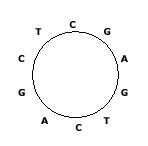Uva - 1584 - Circular Sequence
来源:互联网 发布:知乎电子书是什么意思 编辑:程序博客网 时间:2024/04/29 22:18
Some DNA sequences exist in circular forms as in the following figure, which shows a circular sequence ``CGAGTCAGCT", that is, the last symbol ``T" in ``CGAGTCAGCT" is connected to the first symbol ``C". We always read a circular sequence in the clockwise direction.

Since it is not easy to store a circular sequence in a computer as it is, we decided to store it as a linear sequence. However, there can be many linear sequences that are obtained from a circular sequence by cutting any place of the circular sequence. Hence, we also decided to store the linear sequence that is lexicographically smallest among all linear sequences that can be obtained from a circular sequence.
Your task is to find the lexicographically smallest sequence from a given circular sequence. For the example in the figure, the lexicographically smallest sequence is ``AGCTCGAGTC". If there are two or more linear sequences that are lexicographically smallest, you are to find any one of them (in fact, they are the same).
Input
The input consists of T test cases. The number of test cases T is given on the first line of the input file. Each test case takes one line containing a circular sequence that is written as an arbitrary linear sequence. Since the circular sequences are DNA sequences, only four symbols, A, C, G and T, are allowed. Each sequence has length at least 2 and at most 100.
Output
Print exactly one line for each test case. The line is to contain the lexicographically smallest sequence for the test case.
The following shows sample input and output for two test cases.
Sample Input
2 CGAGTCAGCT CTCC
Sample Output
AGCTCGAGTC CCCT
AC代码:
#include <stdio.h>#include <string.h>#define MAXN 105//环状串s的表示法p比表示法q的字典序小int less(const char* s, int p, int q){int n = strlen(s);for (int i = 0; i < n; i++) {// 循环遍历线性结构是,用对长度取余的方式if (s[(p + i) % n] != s[(q + i) % n]) {return s[(p + i) % n] < s[(q + i) % n];}}return 0; // 相等}int main(){int T;char s[MAXN];scanf("%d", &T);while (T--) {scanf("%s", s);int ans = 0;int n = strlen(s);for (int i = 1; i < n; i++) {if (less(s, i, ans)) {ans = i;}}for (int i = 0; i < n; i++) {putchar(s[(i + ans) % n]);}printf("\n");}return 0;}- UVa 1584 Circular Sequence
- UVa 1584 - Circular Sequence
- UVA 1584 - Circular Sequence
- UVA - 1584 Circular Sequence
- UVa 1584 - Circular Sequence
- UVa-1584Circular Sequence
- 【Uva 1584】 Circular Sequence
- UVa 1584 - Circular Sequence
- UVA 1584 Circular Sequence
- Uva 1584 Circular Sequence
- Uva - 1584 - Circular Sequence
- UVa 1584 - Circular Sequence
- UVA 1584 Circular Sequence
- UVa 1584 Circular Sequence
- UVA - 1584 Circular Sequence
- UVa 1584 - Circular Sequence
- UVA-1584 - Circular Sequence
- UVa 1584 - Circular Sequence
- C++难点—类 (01)
- SVN在Android Studio中的配置
- Android屏幕适配全攻略(最权威的官方适配指导)
- java ftp
- 关于自适应布局的处理利用浮动和margin负边距实现
- Uva - 1584 - Circular Sequence
- 分数类的实现
- org.hibernate.LazyInitializationException:could not initialize proxy
- EHcache配置说明
- Android-Button
- 排序
- 本博客不再更新,移步blog.newboo.org
- n个布尔变量,打印所有可能的真值组合
- JAVA在linux上运行带包的class文件


